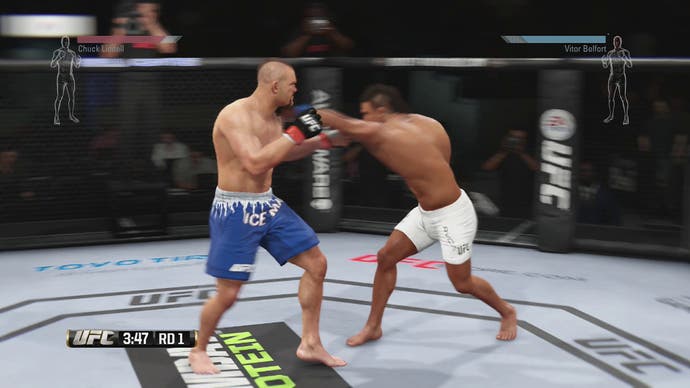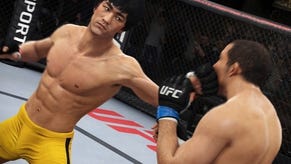EA Sports UFC review
The White stuff.
It all starts with a fistbump.
Actually, it doesn't. 95 per cent of Mixed Martial Arts contests might start with a respectful touch of gloves as the first round starts, but in EA Sports UFC, they do not. It's an odd little omission that, obviously, doesn't affect gameplay - but also demonstrates a developer that's not quite in tune with the sport it's representing.
EA Sports UFC is Electronic Arts' second jab at the complicated, violent, misunderstood and multi-faceted sport of mixed martial arts. The fantastic EA MMA was built in the humid climes of Florida, though, meaning EA Sports UFC is the first step into the cage for the Canadian team responsible for the Fight Night boxing series.
The pedigree is clear from the get-go: gorgeous character models do battle in fluid striking exchanges; skin ripples on impact, heavy blows crunch and crush, flurries dazzle and knockouts shock. Yet on closer inspection, EA Sports UFC begins to act a little strangely. It's like a suave secret agent from the world of boxing desperately trying to convince an army of Dana White devotees that it knows its armbars from its omoplatas.

The easiest way to talk about an MMA game is to break the action down into the three interlocking components that combine to create the sport that so many obsess over: striking, wrestling and jiu-jitsu.
The striking is the easiest to understand and easily the strongest part of the game. Whether you're tussling as Junior Dos Santos and Cain Velazquez in the heavyweight division or throwing leather with Ronda Rousey and the women's bantamweights - MMA is a defiantly egalitarian universe - it'll be hard not to enjoy yourself.
The button-for-limb face button controls are joined by all manner of modifiers, meaning almost every stick direction and shoulder button affects what type of punch, kick, knee or elbow you're throwing. Button-mashers will end up wasting their in-game stamina swinging wildly and inaccurately, but a measured, precise approach reaps its rewards.
The offensive output is matched by blocking, parrying, slipping and dodging options. Two skilled players will dip and dive about the Octagon, moving their heads to avoid jabs and hooks, check leg kicks with their knees and pick the right time to land the perfect strike. Some aberrations exist in the movesets - it's easier to throw utterly bizarre cartwheel kicks with Jon Jones than it is a left hook to the liver - but sensible combatants will create sumptuous chaos in the cage.
In a real fight, striking naturally blends into the clinch. Watch how boxing referees endlessly struggle to keep the two opponents apart from one another. MMA, of course, doesn't require such stringent rules. In EA UFC, clinches don't occur naturally, but must be initiated with a push of the right stick. This is the first indication that EA Sports UFC might not be the organic, 'next-gen' combat experience many had hoped for.

Battling in the clinch demands careful manipulation of the right stick to pummel to a more dominant position - typically achieving 'double underhooks', or moving to a Thai clinch, where an aggressor's hands are locked around the back of his opponent's neck. Battling in the clinch is functional and the animations are perfectly acceptable (and appropriate to real life), but it can feel static and robotic. A real clinch is a struggle: fighters move, they slip and stumble, switch position, attempt takedowns and move to the ground, back each other into the fence or smoothly change angles. Here the action is canned and deliberate, much like it has been in the previous generation of MMA games.
Ground-fighting is much the same. Takedowns are far too rigid. Watch a double-leg attempt in a real UFC fight - it's a back-and-forth war of attrition, never over until the fight is on the floor and the fighter on top has stabilised the position. Here, you have a tiny handful of prescribed animations, all with a small window to be countered. All single-legs end up in side control. For a grappler, it's agonising to watch.
Jiu-jitsu is translated into right-stick quarter-circle exchanges, much like the Undisputed series' approach. A quarter-circle to pass guard; a quarter-circle to move to mount... if you've played THQ's games, you know what to expect. This works fairly well in practice and to be fair, Brazilian jiu-jitsu must be an absolute nightmare to turn into a video game. The real art is one of subtle leverage, positional dominance and trap-setting. It might be unfair to expect a game to capture that.
Still, it's a little frustrating to see no-handed scissor sweeps (a move that barely exists in real life, and certainly wouldn't work on a trained UFC competitor) from guard occurring more than standing passes or knee-on-belly. It's the equivalent of the striking eschewing hooks and uppercuts but letting you throw windmill slaps and arm punches.

Of course, the ultimate goal of grappling is to submit your opponent, and EA Sports UFC incorporates a confusing but strangely tense mini-game to replicate a real-life submission battle. An octagon appears on screen, and the defending fighter must use the right stick to push a bar outwards towards one of four corners, with the attacker matching that right stick direction to block it. Every few seconds, the attacker receives a left-stick prompt to advance the submission, and the mini-game resets. This staggered approach to submissions makes the on-screen fighters themselves look positively daft, but it is extraordinarily tense and genuinely satisfying when you do lock in the sub and get the tap (or choke the poor fella unconscious).
While each individual aspect of its MMA game is rarely less than solid (and in its striking, often spectacular), where EA Sports UFC suffers most is in transition. Each phase of the fight snaps crudely to the next rather than flowing naturally from one to another. It's always been a problem for MMA games, but THQ's Undisputed 3 overcame much of this by animating an absolutely vast number of grappling positions, meaning every ground-fighting exchange or wrestling tussle felt different. Here, it's canned animation on repeat.
This struggle in transition is highlighted by EA Sports UFC's most egregious oversight - the knockdown. Unquestionably the most exciting moment in this sport is when one fighter drops another with a strike then rushes to finish them on the ground. In EA Sports UFC, you either knock an opponent out cold with no option to finish them, or when you do drop them, you're often left swinging at thin air when all you want to do is drop bombs. There are animations to dive onto a prone opponent with a strike, but don't expect to rain down strikes until the referee pushes you off - you fall into either mount or guard, and strike until the opponent loses consciousness.
UFC Undisputed and EA's own MMA offered thrilling mini-games to capture this essential part of the sport. In this respect, EA Sports UFC feels old-fashioned and wooden. Expect the sequel to address this in bullet-point-on-the-box fashion.

Outside the cage, EA Sports UFC is limited but enjoyable. The relatively short development cycle means this is a bare-bones package compared to many EA Sports games. The career mode sees you battling through the Ultimate Fighter TV show before progressing to the UFC itself. It's completely standard stuff - weak training mini-games between fights, weird messages from real UFC fighters - and the AI lacks the sophistication required to make fights feel truly epic.
Online fares much better and highlights just how much stronger EA Sports UFC is in two-player. It mimics FIFA's Seasons mode, with belt promotions replacing divisional ones and championship matches taking place at the end of a successful season. Lag and latency is minimal, and real-life opponents tend to fight with more strategy and caution than their AI-powered peers.
It truly is a multiplayer game, and that's reasonable - no-one would criticise a traditional fighting game for lacking single-player chops. EA Sports UFC comes alive when taking on a real-life opponent. Instead of struggling with the game's deficiencies, multiplayer matches highlight the action at its best.
When battling a real-life opponent, you can gain a greater appreciation for the work this team has undertaken in making star fighters feel, look and move uniquely. Anderson Silva glides in and out of danger, bobbing, slipping, striking with violent precision; welterweight champion Johny Hendrix leaps into his crippling left straight; Mark Hunt lumbers about and throws devastating uppercuts. Also, while the game's grapple-based shortcomings might make it suffer as a spectacle, they're well balanced. Nothing currently feels cheap and exploitable - there is always a way out if you're stuck on the bottom or pressed up against the cage.
EA Sports UFC is a game capable of brilliance. It's let down by some curious design decisions, signs of a team perhaps too interested in capturing non-essential moves seen on YouTube rather than nailing the essence of the sport. But when it flows against human competition, it offers beautiful destruction and glorious drama. Landing a picture-perfect head kick in the final minute of the fifth round of a title fight? Well, it doesn't get much better. And if that's not worth a fistbump, I don't know what is.
















